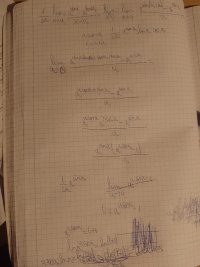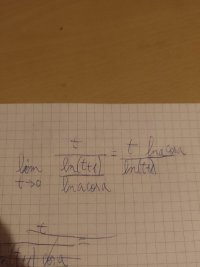You are using an out of date browser. It may not display this or other websites correctly.
You should upgrade or use an alternative browser.
You should upgrade or use an alternative browser.
Power limit
- Thread starter wolly
- Start date
I tried to solve this limit and I got from
[math]\lim_{x \to a}\frac{a^{sin(x)}-a^{sin(a)}}{x^2-a^2}[/math]=[math]\lim_{x \to a}\frac{a^{sin(x)}-a^{sin(a)}}{(x-a)(x+a)}[/math]to
[math]lim_{x \to a}\frac{1}{x+a}[/math]
[math]\lim_{x \to a}\frac{a^{sin(x)}-a^{sin(a)}}{x-a}[/math]
[math]\lim_{x \to a}\frac{a^{sin(x)}-a^{sin(a)}}{x^2-a^2}[/math]=[math]\lim_{x \to a}\frac{a^{sin(x)}-a^{sin(a)}}{(x-a)(x+a)}[/math]to
[math]lim_{x \to a}\frac{1}{x+a}[/math]
[math]\lim_{x \to a}\frac{a^{sin(x)}-a^{sin(a)}}{x-a}[/math]
Dr.Peterson
Elite Member
- Joined
- Nov 12, 2017
- Messages
- 16,619
What would you do if that limit had been [math]\lim_{x \to a}\frac{a^{\sin(x)}-a^{\sin(a)}}{\sin(x)-\sin(a)}[/math]?[math]\lim_{x \to a}\frac{a^{sin(x)}-a^{sin(a)}}{x-a}[/math]
Could you use that as part of your work?
You substituteWhat would you do if that limit had been [math]\lim_{x \to a}\frac{a^{\sin(x)}-a^{\sin(a)}}{\sin(x)-\sin(a)}[/math]?
Could you use that as part of your work?
[math]u=sin(x)-sin(a)[/math]and in my case
[math]u=x-a[/math]
Dr.Peterson
Elite Member
- Joined
- Nov 12, 2017
- Messages
- 16,619
I don't see how that helps. What would you actually do?You substitute
[math]u=sin(x)-sin(a)[/math]and in my case
[math]u=x-a[/math]
I'm hoping to see some more actual work, either on your problem, or on my problem, taken on its own. (I think the ideas from it can then be applied to yours.)
Îs there another method?
@Dr.Peterson
@Dr.Peterson
Dr.Peterson
Elite Member
- Joined
- Nov 12, 2017
- Messages
- 16,619
I'm having trouble following what you wrote. Can you explain, for example, the second line, in words? And then, how you replace sin(u) with u and cos(u) with 1, on the fourth line?
Have you told us yet whether you can use L'Hopital's rule? That's probably the first thing I'd do, coming at this on my own.
Yes, there are usually multiple methods!Îs there another method?
Have you told us yet whether you can use L'Hopital's rule? That's probably the first thing I'd do, coming at this on my own.
Well I used the limit of sinu/u
[math]\lim_{u \to 0}\frac{sin(u)}{u}[/math]and after that I used this part
[math]\lim_{u \to 0}\frac{sin(u)}{u}*u=sin(u)[/math]And sinu/u îs 1 and 1*u îs u
@Dr.Peterson
[math]\lim_{u \to 0}\frac{sin(u)}{u}[/math]and after that I used this part
[math]\lim_{u \to 0}\frac{sin(u)}{u}*u=sin(u)[/math]And sinu/u îs 1 and 1*u îs u
@Dr.Peterson
Last edited:
Well what other methods?You didn't show me!Yes, there are usually multiple methods!
Dr.Peterson
Elite Member
- Joined
- Nov 12, 2017
- Messages
- 16,619
No, you can't let the variable go to its limit in part of an expression, but not in others. This isn't a valid method (except where a theorem allows it, as when you break an expression into a product and take the limit on each factor).Well I used the limit of sinu/u
[math]\lim_{u \to 0}\frac{sin(u)}{u}[/math]and after that I used this part
[math]\lim_{u \to 0}\frac{sin(u)}{u}*u=sin(u)[/math]And sinu/u îs 1 and 1*u îs u
@Dr.Peterson
My point is that you can expect that there will be more than one way to solve any problem. I don't have a specific list of all ways to solve this problem.Well what other methods?You didn't show me!
You haven't answered my question about l'Hopital's rule; if you know it, then we could discuss that. (It leads very easily to a rather ugly answer.)
If you want to use the known limit you mentioned in the OP, try letting [imath]u=\sin(x)-\sin(a)[/imath]. Do you see how you could set things up so that could be useful?
I have a way to solve the problem using the identity:[math]\lim_{x \to a}\frac{a^{sin(x)}-a^{sin(a)}}{x^2-a^2}[/math]
Do I use the limit of
[math]\lim_{x \to 0}\frac{a^{x}-1}{x}[/math]?
I am really stuck here!
[imath]\displaystyle \lim_{x\rightarrow 0}\frac{a^x - 1}{x} = \log a[/imath]
I don't know if professor Dave has figured out that yet.
Well I think that the OP wanna be fancy and challenge himself to not solve it by the boring way (L'hopital rule).Have you told us yet whether you can use L'Hopital's rule? That's probably the first thing I'd do, coming at this on my own.
Dr.Peterson
Elite Member
- Joined
- Nov 12, 2017
- Messages
- 16,619
Yes, I have; my work by that approach includes the substitution I suggested as a key step, as I indicated here:I don't know if professor Dave has figured out that yet.
If you want to use the known limit you mentioned in the OP, try letting [imath]u=\sin(x)-\sin(a)[/imath]. Do you see how you could set things up so that could be useful?
It's entirely possible that it has not been taught yet. Limits like the one you cite could even be taught before introducing derivatives at all (and later used to prove that derivative), though I don't think any of the books I have put it in that order. I try to avoid assuming that knowledge when the work shown suggests otherwise.Well I think that the OP wanna be fancy and challenge himself to not solve it by the boring way (L'hopital rule).
I know the style of the OP. He is someone who is going to ignore the whole thread if he did not understand your hint. Therefore, I suggest that you show him the first few steps.Yes, I have; my work by that approach includes the substitution I suggested as a key step, as I indicated here:
It's entirely possible that it has not been taught yet. Limits like the one you cite could even be taught before introducing derivatives at all (and later used to prove that derivative), though I don't think any of the books I have put it in that order. I try to avoid assuming that knowledge when the work shown suggests otherwise.
Any way my approach is what you should do if your limit does not match the identity exactly.
First, you have to notice this:
[imath]\displaystyle \lim_{x\rightarrow 0}\frac{a^x - 1}{x} = \lim_{x\rightarrow a}\frac{a^{x - a} - 1}{x - a} = \log a[/imath]
Then, you introduce [imath]A(x,a)[/imath] and [imath]B(x,a)[/imath]:
[imath]\displaystyle \lim_{x\rightarrow a}\frac{a^{A(x,a)} - 1}{B(x,a)} = C(a)\log a[/imath]
where [imath]C(a)[/imath] is a secret function for now.
And the main point of doing that is how to find [imath]C(a)[/imath] when [imath]\displaystyle A(x,a) \neq B(x,a)[/imath] as in the OP limit. It is a beautiful idea, but it has some restrictions.
Last edited:


